It’s no secret that guitar amplifiers can play a crucial role in shaping the sound of an electric guitar. Although speakers are technically not part of the amplifier, look on any guitar form, and you’re bound to bump into the seemingly age-old question, which is better, 8″ vs 10″ vs 12″ Guitar Amplifier Speakers?
In this article, I’ll delve into the pros and cons of each speaker size to help you determine which is the best option for your particular needs. So, keep on reading to learn more!
You can use the table of contents below to take you to the area that interests you. Click on the little box to open it and then click on the section of the article you want to read, or you can read from start to finish if you want the full speaker size experience!
The Short Answer
8-inch speakers give you portability and focused sound, while 10-inch speakers have sound characteristics between the 8 and 12-inch speakers, and 12-inch speakers provide a stronger low-end and wider sound dispersion. Factors such as tone and frequency response, speaker volume, amplifier headroom, sound projection and dispersion, and speaker portability and weight can vary with speaker size.
Keep On Reading (Below) To Learn More
What Is A Guitar Speaker?
For those who do not know, here is a simple explanation of what an audio speaker is and how it works.
A speaker (also called a loudspeaker) is a device that receives an audio signal from an amplifier and converts it to the sound we hear. The audio signal is created by the notes you play on your guitar.
When the speaker receives an A.C. (alternating current) audio signal, it creates an electromagnetic field in a coil of wire (also called a “driver”). The electromagnet interacts with the speaker’s permanent magnet, which causes the speaker’s cone to move back and forth quickly.
As the cone moves, it pushes and pulls the air around it, creating sound waves. These sound waves travel through the air and reach our ears, allowing us to hear the music.
This diagram from Electronix Learning Center and Blog shows the location of a speaker’s cone, magnet, and coil.
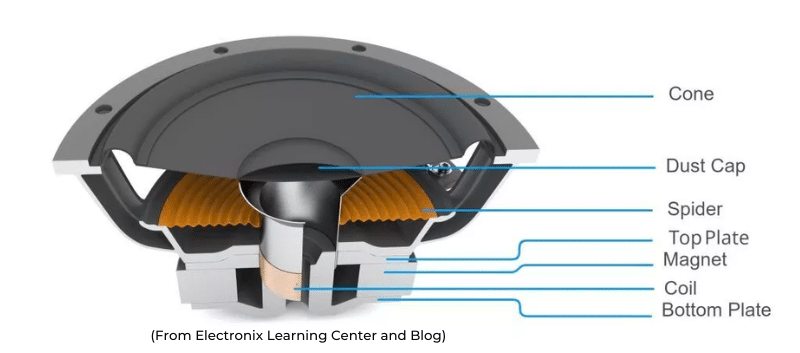
Each speaker is housed in a box (cabinet) that helps to directionalize and improve the quality of the sound.
Guitar “combo” amplifiers have the amplifier and speaker(s) in a single cabinet, while “stack” amps (like a Marshal stack) have separate cabinets for the amplifier and the speakers.
Things To Consider When Selecting Speaker Size
Here are the essential things to consider when selecting a speaker size.
Tone and Frequency Response
Various speaker sizes can produce different tones and frequency responses. Smaller speakers usually provide a brighter tone with a tighter bass response. They also tend to be more crisp and articulate, which helps them really cut through the mix.
As the speaker size increases, the tone becomes warmer and deeper, with an enhanced, more rounded, and full-bodied bass response.
Speaker Volume
Are bigger speakers always louder? No, not always. Although you would expect that, for example, a 12-inch speaker would always be louder than a 10-inch speaker plugged into the same amp, it relies on several other factors like speaker design, efficiency, impedance, magnet specs, and power rating.
Guitar speakers come rated at different impedances, like 4, 8, and 16 Ohm.
A speaker that is rated to handle more power may not be as loud as one of the same size that’s rated to handle less power when plugged into the same amp. This may be because the amplifier is not powerful enough to drive the speaker properly.
All these factors come into play
What About Headroom?
If you have an amplifier with an excessive amount of headroom, you need to be sure that your speakers are built to handle it without sustaining damage to their component parts. Usually, selecting a speaker with a power rating equal to or greater than the amplifier’s power output will be ok.
Many of the high-power guitar amplifiers have two to four speakers to safely handle the power.
Sound Projection And Dispersion
Sound projection and dispersion become important for things like the room and audience size or if you’re playing outdoors.
If you’re not planning on mixing your guitar amp through the PA system, you’ll need a speaker arrangement that will move enough air and a big enough amplifier to drive it. So, a good rule of thumb is the bigger the venue, the bigger the speaker size.
So if you plan on using your guitar amp for studio recordings or performances in small venues, like clubs, a combo amp with 8 or 10-inch speakers will work fine. However, if you’re playing in larger venues or outdoors, you’re probably better off going with an external speaker cabinet with four 12-inch speakers.
For my money, there’s nothing like a Marshall stack with two 4X12-inch speaker cabinets to get your sound out in front of an audience!
Portability And Weight
Another important consideration is the portability and weight of your guitar amplifier. Bigger speaker sizes can weigh significantly more. Therefore, you have to balance a speaker’s tone and sound projection against its weight.
There are some really great-sounds amps with a single 8-inch speaker, like a Supro Delta King 8, which might be your best bet if you’re constantly playing “on the go.”
For example, if you do a lot of studio recording, my preference would be a small combo amp, like a Fender Deluxe Reverb amp with one 12-inch speaker.
You could go bigger with something like a Fender Twin Reverb if you need two 12-inch speakers to play in bigger spaces, like clubs.
If you want something bigger but heavier, like a 4×12 speaker cabinet, you’ll probably need a cabinet with wheels to make it easier to move from one place to another.
Pros And Cons Of Different Speaker Sizes
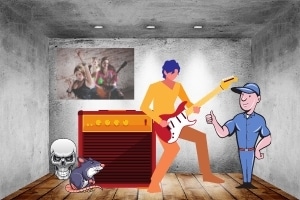
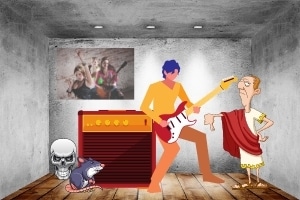
Here is a quick summary of the advantages and disadvantages of each of the three speaker sizes.
You can click on each size in the chart below to learn more.
| Size | Pros | Cons |
|---|---|---|
| 8-Inch Speaker | 1. Lightweight 2. Focused sound 3. Great for recording 4. Versatile | 1. Limited low-end response 2. Coverage & projection limitations |
| 10-Inch Speaker | 1. Balanced tone 2. Versatile 3. Good projection 4. Enhanced low-end response | 1. Moderate portability 2. Limited bass depth |
| 12-Inch Speaker | 1. Powerful & full-bodied sound 2. Excellent bass response 3. Wide sound dispersion 4. Ideal for larger venues | 1. Weight and size 2. Less focused sound |
Keep On Reading (Below) To Learn More About Each Topic
8″ Guitar Amplifier Speakers
Eight-inch guitar speakers are a popular choice for small practice amps. However, some expensive boutique amps feature them as well.
In addition to making a guitar amp more portable, they tend to have a more focused sound with a tighter low-end response.
They’re a popular choice among Jazz and Blues players.
Pros
- Portability: 8-inch speakers are lightweight and easy to transport.
- Focused sound: They provide a tight and focused tone, ideal for genres that require precision and articulation.
- Great for recording: The focused sound projection makes them suitable for studio recordings and close-mic situations.
- Versatility: 8-inch speakers can handle a wide range of playing styles, from jazz to blues and even rock.
Cons
- Limited low-end response: Due to their smaller size, 8-inch speakers may lack the deep and powerful bass response compared to larger speakers.
- Coverage limitations: In larger venues, 8-inch speakers might struggle to provide sufficient coverage and projection.
If you want a small, lightweight amp that’s ideal for home practice, easy to take to gigs, and can give you a good tone, check out some of the models that feature one 8-inch speaker.
Here are ten examples of amps that have one 8-inch speaker.
- Fender Champion 20
- Orange Crush 20
- Roland Cube-10GX
- Peavey Rage 258
- Line 6 Spider V 20 MKII
- Bugera V5 Infinium
- Blackstar HT-1R MkII
- Magnatone Starlite
- Supro ’64 Reverb
- Vox VX50 GTV
My Speaker Choice
I particularly like the sound of the Jenson Special Design 8-inch speakers. I have used them as replacement speakers for a variety of vintage combo amps.
It has a ceramic magnet that gives it a warm tone with a focused low-end and responsive highs. The speaker takes pedals well. It comes in 4 or 8 Ohms and is rated to handle 25 Watts.
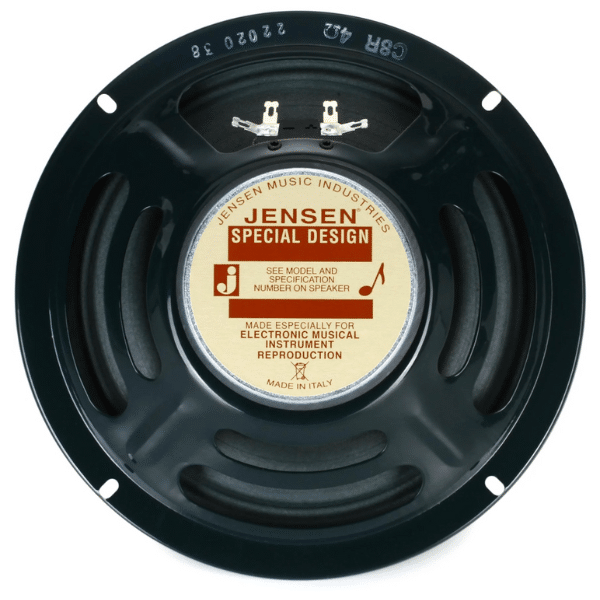
Click HERE To Check Reviews & Price On Amazon
I highly recommend it if you’re looking for a creamy sound with dirt pedals like overdrive or mild distortion!
Click Here To Read My Full Review!10″ Guitar Amplifier Speakers
Ten-inch speakers typically offer a more robust and fuller sound than an 8-inch size. They sit somewhere between the 8-inch and 12-inch sizes in terms of tone.
Amplifiers with 10-inch speakers offer a balance between portability and power. They’re great for both garage band sessions and small to medium-sized gigs.
Their versatile range of tones can accommodate any musical genre and playing style.
If you’re looking for a speaker that can easily cover all styles of music with good power-handling capability and on the lighter side, a ten-inch speaker might fit the bill.
Pros
- Balanced tone: 10-inch speakers strike a balance between the focused tone of smaller speakers and the fuller sound of larger ones.
- Versatility: They can handle various playing styles and genres, making them a popular choice among guitarists.
- Good projection: 10-inch speakers offer decent sound dispersion and projection, suitable for both small and medium-sized venues.
- Enhanced low-end response: Compared to 8-inch speakers, 10-inch variants provide a more pronounced bass response.
Cons
- Moderate portability: While still relatively portable, 10-inch speakers are slightly heavier than their 8-inch counterparts.
- Limited bass depth: Although they offer an improved low-end response, 10-inch speakers may not deliver the same level of deep bass as 12-inch speakers.
Here are Ten examples of amps that have one 10-inch speaker.
- Fender Tone Master Princeton Reverb
- Vox AC10C1
- Orange Crush 35RT
- Marshall MG30GFX 30
- Dr. Z Carmen Ghia 35th-anniversary
- Line 6 Spider V 60 MkII
- Supro 1612RT Amulet
- Mesa/Boogie Mark Five:25
- Behringer HA-40R
- EVH 5150 Iconic Series Combo
My Speaker Choice
So, I’ve played through a lot of amps with 10-inch speakers, but I favor the tone of the Eminence GA10_SC64. What I really like about it is its rich-sounding midrange and sparkling highs.
It has a ferrite magnet and is rated at 20 Watts. It comes in 8 and 16 Ohms.
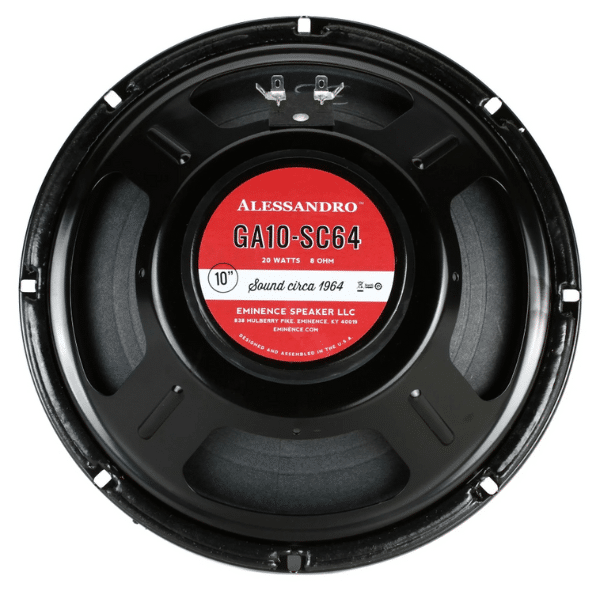
Click HERE To Check Reviews & Price On Amazon
I have an old Randal speaker cabinet that has two SC64s. I use it for everything, but it sounds especially great in my recording studio.
Click Here To Read My Full Review!12″ Guitar Amplifier Speakers
Twelve-inch guitar speakers are known for their power-handling capability and enhanced low-end. This has made them a very popular choice among Rock and Metal players who crave a heavier and more powerful sound.
Additionally, 12-inch speakers tend to disperse sound more effectively, covering a wider area and providing better stage presence.
A guitar amp with just a single 12-inch speaker will give you a noticeably “bigger” and “darker” sound than a 10-inch speaker.
Marshal was the first to combine four 12-inch speakers into a single cabinet. So, a double Marshall stack gives you eight 12-inch speakers. Playing onstage through a wall of Marshall amps is every Rock and Metal player’s dream!
Pros
- Powerful and full-bodied sound: 12-inch speakers excel in producing a rich, deep, and powerful tone.
- Excellent bass response: They offer the best low-end response among the three sizes discussed, making them ideal for genres that require a strong bass presence.
- Wide sound dispersion: 12-inch speakers provide wider coverage, ensuring better projection and stage presence.
- Ideal for larger venues: These speakers can easily fill larger spaces with sound, making them suitable for live performances.
Cons
- Weight and size: 12-inch speakers are the largest and heaviest among the options, which can make them less portable and more challenging to transport.
- Less focused sound: Compared to smaller speakers, 12-inch variants might have a tone that is less focused and tight.
Here are ten examples of amps that have one 12-inch speaker.
- Fender Blues Junior IV
- Marshall DSL40CR
- Blackstar HT-5R MkII
- Peavey Classic 30
- Roland Blues Cube Hot
- Mesa/Boogie Fillmore 25
- Bugera V22 Infinium
- Boss Katana-50 MkII
- Line 6 Catalyst 60
- Vox AC15C1
My Speaker Choice
When it comes to 12-inch speakers, I’m definitely a Celestion Greenback guy. This speaker virtually defined the sound of Rock N’ Roll and is still a very popular choice in Marshall 4×12 cabinets.
They’re rated at 25 Watts and come in 8 and 16-ohm configurations.
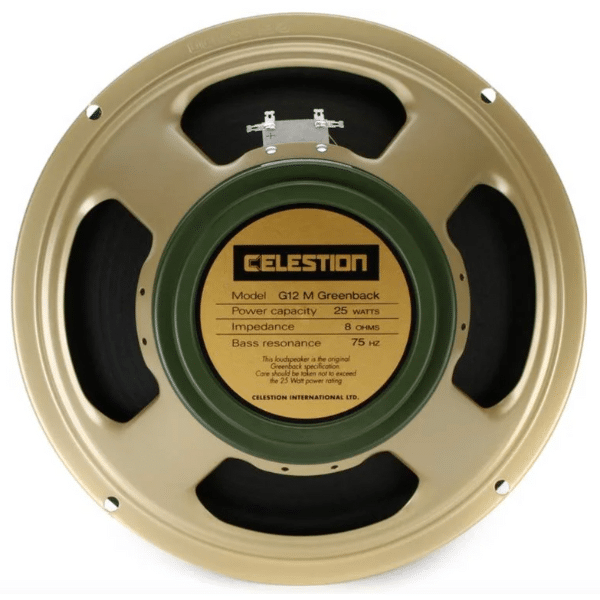
Click HERE To Check Reviews & Price On Amazon
They’ll give you that classic British overdriven and distorted sound that cleans up to a chimney-clean tone when you turn down your guitar volume!
Click Here To Read My Full Review!What Else Matters?

So, what are some of the other things you need to consider when choosing a speaker size?
Genre, Playing Style, And Skill Level
Guitarists of certain musical genres, playing styles, and skill levels seem to gravitate toward specific speaker sizes. For example, beginners often buy “student” amps with an 8-inch speaker or smaller.
I’ve seen Jazz and Blues players prefer a 10-inch speaker size, which provides clarity, articulation, and a well-balanced low-end. You can’t go wrong with this speaker size, which can cover any genre. Jazz Fusion and aggressive Blues players tend to prefer 12-inch speakers.
Rockers and Metal players gravitate toward the heavy sound of the 12-inch speaker size. You know how much air these speakers can move if you’ve ever played through a 4X12 cabinet.
Personal Preference
When it comes to speaker size, there are no hard and fast rules. What sounds good to you may not be attractive to another player. However, it’s good to always have your audience in mind when you choose a speaker size.
For example, if you play mellow Jazz, you don’t want a harsh-sounding speaker just because you like the way it cuts through the mix onstage.
The “Cool” Factor
Let’s not forget what attracted many of us to the electric guitar, to begin with. Yes, the cool factor can figure into your speaker size prominently!
When I first began playing, I thought there was nothing cooler than a wall of stacked amps! Bands like Jimi Hendrix, Led Zeppelin, and Deep Purple conquered the stage with a wall of Marshall 4X12 speaker cabinets.
Back then, I would have given anything to have Tony Iommi’s wall of Laney cabinets, which made Black Sabbath stand out onstage as being different from the other Rock and Metal masters.
The look and sound of your amp can definitely influence the way you play. I’ll play differently when I use my Supro ’64 Reverb combo with its single 8-inch speaker versus running the same amp into a 4×12 cabinet.
Can You Change Your Amplifier’s Speaker Size?
Yes, you can. However, there are a few things to know before you proceed.
First, the easiest approach is to get a new speaker cabinet with the number of speakers you want in a particular size. For example, if you have a cabinet with two 10-inch speakers, you can swap it for a cabinet with two 12s.
I would not recommend trying this with a combo amp because you would have to disassemble the amp and change the size of the speaker cutout, which is typically more trouble than it’s worth.
Next, be sure to read the next section below on the importance of matching speaker impedance and power-handling ratings to avoid damaging your amp and speakers!
Beware Of Speaker Ratings!
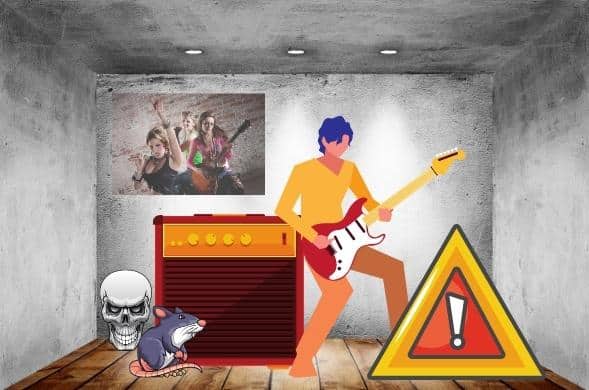
The most important thing to know about changing speaker size is that the new speaker must be rated to work properly with the amplifier. So, you need to match the new speaker’s impedance and power handling capability to what you originally had.
If your cabinet has more than one speaker, depending on the way they are wired (in series, parallel, or series-parallel), the total impedance and power handling must match your amplifier’s ratings.
Therefore, you can’t swap out a single 10-inch speaker rated at 8 ohms for another rated at 16 ohms unless your amp is designed to run at both impedances. Always match or exceed the new speaker’s power handling capability to avoid damaging it.
If you’re not sure, it’s always best to ask someone who knows!
So, What Speaker Size Is Best?
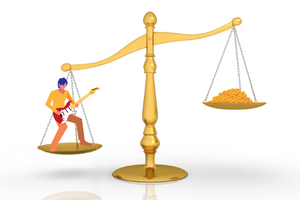
There is no one best speaker size. It depends on things like the size, weight, and power output of a guitar amp and, most importantly, the tone you are looking to get.
Don’t underestimate a guitar amp just because it has a small speaker. I’ve played through some pretty loud amps with a single 8-inch speaker! I have a little Gorilla Amp with one 8-inch speaker, and with a hot guitar and a dirt pedal, it’ll definitely wake up the neighbors!
If it has the sound and performance you want, then go for it. You can always mic it through the house PA system if you’re playing out and you need more volume.
My Personal Speaker Size Preference
I generally prefer 12-inch speakers in a 2×12 or 4×12 cabinet configuration for playing with a band. They give me the coverage I need, and I can modify their sound by adjusting the amp or using effects pedals.
I’ll usually go smaller, with 8 or 10-inch speakers for home use and in the recording studio.
If you plan on buying one guitar amplifier for all-purpose use, you’re probably better off going with a 10-inch speaker because it is the most versatile.
On the other hand, if you’re looking to add a second guitar amp to your sonic arsenal, you might want to get a speaker size that compliments your original purchase. For example, if your old amp has 8-inch speakers, get one with 12-inch speakers. This will give you the broadest range of tones.
Try Before You Buy!

One key thing to remember is that the sound you hear is a combination of the guitar you use, the amplifier’s electronics, and your speakers. So, don’t ever underestimate the importance of any of those components!
Therefore, play your guitar through several different amps to find what you like best, don’t just go for something with the biggest speakers because it looks cool and sounds loud!
You can bring your amplifier to your local guitar shop and plug it into various compatible speaker cabinets to hear which one you like best.
Everyone’s playing style is a bit different, so no two people will sound exactly the same. You need a guitar rig that will bring out your particular tone, and speaker size is definitely a consideration.
Frequently Asked Questions

Here are some of the questions I get asked about guitar speakers.
If your question does not appear here, please put it in the comments, and I will get right back to you with an answer.
What Wattage Speakers Do I Need For My Guitar Amp?
The wattage of your speakers should match or exceed the power output of your guitar amp.
Are 8-Inch speakers Loud Enough For Live Performances?
While 8-inch speakers can work well in smaller venues or recording studios, they may struggle to provide sufficient volume and coverage in larger live settings.
Does Speaker Size Affect Volume?
Generally speaking, a larger speaker size can be louder because it pushes more air, but it also depends on many other factors.
Do Speaker Sizes Affect The Overall Weight Of The Amp?
Yes, larger speakers tend to add more weight to the amplifier compared to smaller speakers. Weight can be a consideration if you frequently need to transport your amplifier.
Can I Change The speaker Size In My Existing Guitar Amp?
Amplifiers can be connected to external speaker cabinets with different size speakers, but they have to be compatible with the amp’s power handling and impedance specifications and properly installed.
What Happens If Speakers Are Too Powerful For An Amp?
If your speakers have a power rating that is much higher than your guitar amp, it can cause your amp to work too hard to get the sound and volume you need. This can overwork the amplifier, causing it to distort and become damaged.
A good rule of thumb is to avoid using a speaker that has more than twice the power handling capacity of the amplifier.
Always match the power rating of a replacement speaker to what was previously in your amp for best results.
Can You Plug A Guitar Directly Into A Speaker?
No, you need to plug your guitar into an amplifier, which sends the sound of what you play to the speaker.
Which Speaker Size Is Best For Recording?
Various artists use different size speakers in the studio, but 8 and 10-inch speakers are the most popular. However, rock and Metal guitarists tend to prefer 12-inch speakers for their “heavier” sound.
Can I Use Different Speaker Sizes Together In One Amplifier?
Yes, some amplifiers come with different speaker sizes to help improve the amp’s tone and frequency range. However, matching the impedance and power rating of each speaker to your amplifier’s ratings is essential.
Final Thoughts

So, there is everything you need to know to understand the basics of selecting guitar amplifier speakers. But remember, when it comes right down to it, there is no “one speaker fits all” approach. It largely depends on your specific needs, playing style, genre, and the types of venues you perform in.
8-inch speakers give you portability and focused sound, while the 10-inch speakers have sound characteristics between the 8 and 12-inch speakers. The 12-inch speakers provide a stronger low-end and a wider sound dispersion, which is ideal for larger venues.
Always remember to consider factors such as tone and frequency response, speaker volume, amplifier headroom, sound projection and dispersion, and speaker portability and weight.
If you change speakers, you can use a different size, but it’s essential to match the total impedance and power output of the originals. Failure to do so may result in damage to your amplifier and speakers!
Playing through amplifiers with various speaker sizes is a good idea to hear the differences.

Here’s a video from Fender University that shows you how to replace a speaker in a rear versus a front-loaded speaker cabinet. If you’re not comfortable doing the replacement, take your amplifier to a certified technician to avoid damaging your equipment!
Related Article ➡ What Size Guitar Amp Do You Need? – Ultimate Guide!
Tell Me What You Think

Please leave a comment below if you enjoyed this article, have any questions about speaker size, or want to give your point of view. I will be happy to help you.
- What is your favorite speaker size, and why?
- How important do you think speaker size is for getting your overall tone?
- Did this article make you want to reevaluate the speaker size you’re currently using?
- What else is on your mind?



Nice to see your site, Frank — Lookin’ good.
Wow! Now, that was a thorough pile of information you threw at us. I learned some things. Of course, I don’t need a guitar amp…wish I could afford a new bass amp. I really liked my old bass amp — it was a Fender, large enough to do a good job but small enough so I could move it. Wish I still had it!
What I have now is just a little practice amp, and it’s thinking of giving up on me. Guess it’s time for a new bass amp.
Hi, Fran!
Thank You for your comments! I’m very excited that you had a look at my site! 😎
Sorry to hear about your bass amp. Perhaps it just needs a little TLC. You might only need a speaker replacement if it’s a solid-state design. Bass amps are typically harder on speakers than guitar amps.
Let me know if you need some suggestions for bass amps, and I’ll be glad to help! You don’t have to spend a pile of money to get something nice for practice or a small jam session.
Rock On! 🤘
Frank 🎸
Hey, I’m so happy to see your post and read your content among all posts. Lately, I was searching for a new amplifier but I didn’t have much information about that. You described everything comprehensively and that is awesome. I read it carefully and save your post. I’m sure it will help me a lot.
Thanks, Liam!
Let me know if you need any help choosing a guitar amp. 😎
Rock On! 🤘
Frank 🎸